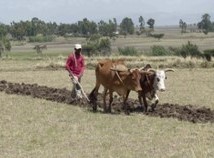The ANC is deluded about its proposed distribution of land. Perhaps ‘One Household One Hectare’ is just a political slogan.Either way the ANC’s ideology perpetuates it’s delusion.
The average grain farmer borrows up to R10m in working capital from the bank each year, plants his crops, and then prays for rain, said Grain SA executive director Jannie de Villiers last week.
For these farmers, the key problem is not (yet) the threat of expropriation without compensation (EWC), but how to maintain profitability in the face of debilitating drought and costly, inadequate infrastructure. (It now costs more to rail or truck maize down from the north than it does to import it from Brazil to the Western Cape, says Mr de Villiers.)
What then is the government’s plan to cope with debt when it expropriates farms, or to maintain production on them thereafter?
As regards debt, acting valuer general Pelekelo Mwiya sees no problem in valuing a farm identified for EWC at ‘a nominal value of R1’, as he told the ad hoc parliamentary committee charged with developing an EWC constitutional amendment last month. But what if there is a bond of R10m on the farm? he asks. If the state takes on that liability, it might end up paying even more than market value.
The implication, though Mr Mwiya did not spell this out, is that commercial banks – if they fail to recover their loans from expropriated farmers – will be left to take the hit. This suggests that few banks may be able or willing to keep lending to new farmers operating on expropriated land.
How then is production to be maintained? The simple answer, according to the Department of Rural Development and Land Reform, is that the state will in future provide new farmers with all they need.
According to the department, land acquired or held by the state (including communal land under traditional councils) will be divided into one-hectare plots, each of which will become home to one household and two dairy cows. This is to be done under the state’s existing ‘One Household One Hectare’ (1HH1HA) programme and its proposed ‘One Household Two Dairy Cows’ (1HH2DC) policy.
In the ANC/SACP’s fantasy world, the state will then supply these millions of households with all the support they need: from farm implements to fertilisers, seeds, cows, chickens, pesticides, pack sheds, irrigation, fencing, and broiler units.
All one-hectare households will also be organised into primary co-operatives, which in turn will be organised into secondary co-operatives, which in turn will jointly own a 70% share in the agriparks being established to provide agri processing and marketing.
These plans are neatly laid out in diagrams and organograms in a June 2017 briefing document compiled by the land department. Agriparks are already being established, while close on R300m has been budgeted to settle an initial 6 700 households on their one-hectare sites.
Since 1994, however, the government has signally failed to provide adequate support to a relatively small number of land reform beneficiaries. How then will it cope with the needs of millions of 1HH1HA/1HH2DC smallholders?
South Africa is also a water-stressed country where one hectare often has limited crop-carrying capacity. In many areas, moreover, no fewer than five hectares are needed to support a single head of cattle. Hence, one hectare will often support a mere fifth of a cow – rather than the two dairy cows the government’s neat diagrams envisage.
In addition, South Africa is already 65% urbanised and is likely to be 70% urbanised by 2030. How are the cities realistically to be fed if so much of the country’s farm land is to be turned over to small-scale farming? A return to farming is also not what most South Africans want, as the shift to the cities so clearly shows.
The ANC’s aim, however, is to turn the clock back to 1913 and restore ‘the beauty of ubuntu’ (as the June 2017 document puts it) by getting millions of people to take up peasant farming. Most South Africans, if they were to be asked, would roundly reject this as their aim in life.
Why on earth would any government in the 21st century want to pursue such an antiquated objective? The answer – as so often with the ANC/SACP alliance – lies in its ideology.
A key goal of the national democratic revolution (NDR) to which the ANC recommits itself every five years, is to wean people off their current dependency on the capitalist system for employment, food, and other needs. Another vital aim is gradually to replace private ownership with both state and ‘social’ ownership – a strong co-operative sector being crucial to this last.
The 1HH1HA/1HH2DC scheme will help achieve both these goals. It will also make sure, or so the ideologues claim, that every household has food to eat, produce to sell, and a secure place in a caring, co-operative society.
People will also, as in Cuba, have the opportunity to revert to ‘ox-drawn ploughs’. This, says the SACP in The South African Road to Socialism, should not be seen ‘as a step back into the past’, but rather as a step forward into ‘a socialism of the 21st century’. That, of course, is what they also have in Venezuela…
Dr. Anthea Jeffery is the Head of Policy Research, IRR

